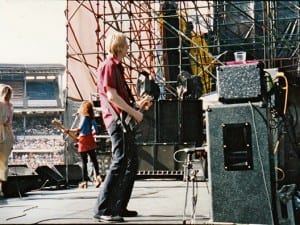Clio Barnard’s exploration of playwright, Andrea Dunbar’s life, combines reality with artifice in an exciting new cinematic creation.
In recent years, viewers have witnessed a surge of popularity in documentary from the opinionated outputs of Michael Moore, to the staged realism of The Hills, the appetite for the personal and the intimate remains insatiable. In fashion and music there has been a movement away from high-octane glamour and the latest, logo-emblazoned “it bag”, to quietly luxurious neutrals, long-term quality investment pieces, and burgeoning pop stars whose journey we’ve witnessed from the very beginning. Realism is all around us. Now in a challenging new genre, acclaimed documentary filmmaker, Clio Barnard, creates a transitional world between fact and fiction – highlighting the struggles of social depravation, aggressive racism, and powerful addictions through the prism of the flexibility of memories and the ever-ambiguous nature of reality.
In association with Artangel and the UK Film Council, Clio Barnard’s feature-length film, The Arbor, explores the life and legacy of Bradford’s literary success story, Andrea Dunbar, through extensive interviews with her siblings, lovers and children, lip-synched by an accomplished cast of actors, playing out the real words and emotions of their subjects. Plucked from obscurity after completing a remarkable school project aged just 15, Andrea Dunbar’s first play, The Arbor, showed at The Royal Court three years later. It was inspired by Dunbar’s experiences on the Buttershaw Estate where she grew up, and the trials and tribulations of a family wrecked by alcoholism, her teenage pregnancy, inter-racial relationships, and domestic violence. Strikingly autobiographical, Dunbar’s play brought an unglamorous realism to the London stage, and her status was cemented with the later screen-adaptation of her second play, Rita, Sue and Bob too (1986), which went on to become a 1980s cult classic. Then Artistic Director of The Royal Court, Max Stafford-Clark, recognised a “very sharp, very alive and very witty” voice in Dunbar’s work and “her ear for dialogue is remarkable.” Dunbar died at the age of 29, never having moved away from Bradford, and leaving behind three children by three different fathers. Ten years after Andrea Dunbar’s death, Stafford-Clark commissioned A State Affair, to investigate how the Buttershaw Estate, so central to Andrea’s writing and the formation of her character, had evolved over the decade. The hard hitting drama brought home a damning critique of an area left behind in the economic surgence of New Labour and Cool Britannia – and the words of Dunbar’s eldest daughter, Lorraine, proved to be the legacy left for most: “If my mum wrote the play now Rita and Sue would be smack heads…on crack as well…and working in the red light district, sleeping with everybody and anybody for money.” Buttershaw was disintegrating under cheap heroin.
A Bradford contemporary of Andrea Dunbar, Clio Barnard approached Artangel with a proposal to revisit the Buttershaw Estate, 10 years on from A State Affair: “I was interested in the idea of revisiting and reflecting on the previous representations of Buttershaw.” The project took Barnard on a journey of discovery through Andrea Dunbar’s old stomping ground as Lorraine Dunbar slowly emerged as the focus of the work. Lorraine’s story is remarkably tragic, one of drug addiction, criminal convictions, appalling domestic violence, prostitution and extreme depravation. Lorraine’s life and accounts of childhood contrast with those of her younger sister, Lisa, who has grown into a proud daughter leading a simple, conventional family existence in suburbia. On her explorations of Buttershaw, Barnard was struck by the autobiographical elements of Dunbar’s work: “Realising the character of Yousaf in Andrea’s play The Arbor was Lorraine’s father was key,” and it becomes evident that through her various tragedies, Lorraine has lost the ability to create an autobiography herself. In such a manner, Barnard muses on this wasted existence, and The Arbor becomes very much a tale of Lorraine’s journey, as well as an opportunity to “look across three generations of a family and three decades of a particular place, to allow some understanding of the destructive effects of poverty, racism and addiction to emerge.”
Barnard spent two years recording interviews with the Dunbars and residents of Buttershaw to collect an extensive archive on Andrea, her world and her legacy. These recordings form the basis of the film, as actors take on not only the words of the real-life characters, but also the voice, intonation, emphases and pauses in an exciting collaboration between fact and fiction. Borrowing from verbatim theatre, The Arbor manipulates reality further by creating private moments with the character, through the face of the actor. While the lip-synching is second to none, and it is easy to forget that the actors are not physically speaking the words, the viewer finds themself returning again and again to the precept in a manner that undermines the realism of the film. Barnard’s constructed reality occupies a confusing realm – each interviewee presumably speaks the truth, or at least their version of it, but in referring back to the technique we are constantly reminded of its artifice – even when the actors are removed the very nature of Barnard approaching the characters for a formal interview creates a confessional artifice in itself. It is not a usual situation, and each and every one of us would think about our presentation, how we would come across not only to the cinema audience, but more personally to the director who has an opportunity to create a public image for us. In a manner, The Arbor echoes Dunbar’s own methods – she was credited with penning only what she knew about, and so her three plays are inevitably autobiographical, referencing her own life and those of the people around her, while retaining the ability to censor at will and operate a selective memory at times. Similarly, Barnard’s work falls short of traditional documentary through the sheer extent of time spent with the Dunbar family – the interviewer can never be impartial and while Barnard acknowledges: “I formed strong bonds with the people that I interviewed for the film,” she still viewed her role “to be non-judgemental and to listen.”
Through the use of real-life audio, The Arbor takes an intensely personal form, and in spite of the contrived atmosphere of staging an interview for film, the impression remains of an indiscriminate honesty from Lorraine and Lisa. (Interestingly, Andrea’s son Andrew, remains defiantly removed from the emotion aroused in his siblings: “I don’t remember much of me childhood really, we moved about a bit as a kid,” and to Barnard this “speaks volumes. He was only seven-years-old when Andrea died.”) Taking centre stage, the intense and massively differing memories of Lorraine and Lisa lead to an inconclusive debate on, not only the manipulation of fact and reality, but also the very nature of memory itself. Recounting the same story of a fire in their childhood bedroom, Lisa is affectionate in remembering the mischievous antics of childhood, believing herself to be responsible for the locked door, while Lorraine recollects more sinisterly how Andrea would remove the outside doorknob to their room, imprisoning her own children. Lisa recounts how, “to this day I won’t hear a bad word about me mum”, while Lorraine describes the relief felt at Andrea’s funeral, feeling a great weight lifted, as though her real life could finally start. Tragically at this point, Lorraine finds what becomes the central theme of her life, drug addiction, and her new start simply sees her slip into a hell that was, outwardly at least, absent in her mother’s lifetime. The Arbor’s ability to illustrate the flexibility of memory is illustrated in Lorraine’s pivotal moment overhearing Andrea’s drunken remark that she cannot love her mixed-race daughter as much as her two younger children. From there onwards Lorraine’s story is framed by this maternal rejection, and its exposition mid-way through the film betrays the basis of the narrative before it – even before the audience hears of Andrea’s comments, her daughter’s contempt is tantamount to this small, but central event. Barnard’s direction unveils the selective nature of memory, and adds its contribution to the debate of the metafictional narrative that The Arbor undertakes. Barnard asserts: “The formal techniques are about deliberately creating distance and reminding the audience that they are watching something constructed and necessarily mediated through the language of film/theatre.” In also exposing the sisters’ widely varied viewpoints of their upbringing the film achieves the effect of metafiction because the audience is constantly reminded of their role as onlookers in a narrative.
As a Bradford native herself, Barnard’s childhood could contribute to the discussion of memory, but she is clear in the distinction: “If you are from the other side of Cooper Lane, which runs around the periphery of the estate, you are considered an outsider on Buttershaw, so I make no claims to being an Arborite.” There’s an impression that, while Barnard’s initial draw to Dunbar’s story may have stemmed from local pride, there was no intention to reveal much of herself in the story – in this manner, Barnard may have served to hinder the realism of her venture, or may have displayed admirable restraint in not laying claim to the story of The Arbor. As it stands the film is remarkable in its weighty, hard-hitting subject matter – to the extent of becoming an assault on the sensibilities at certain points as Lorraine’s downward spiral becomes hard to bear, even for the audience.
For those of us who know Bradford, as a thriving, multi-cultural market town, a short ride from the bustling urbanity of Leeds, and the rolling rugged hills of rural Yorkshire, The Arbor paints a gritty British soap opera of the lives of its inhabitants. On discussing the common southern cry of “it’s grim up north” Barnard defends her subject matter: “The ‘grim up north’ myth is a convenient ‘othering’ for southerners.” But as Andrea’s alleged alcoholism gives way to Lorraine’s desperate heroin addiction, we sense these women are representative of thousands around them, and so The Arbor is dark, depressing and ultimately hard work. It remains thought-provoking in raising the fact that, although not representative of the town, many across the UK are living this existence every day. “Bradford and the UK should be confident enough to embrace Andrea Dunbar’s writing without worrying that it gives a bad impression. We shouldn’t be brushing this under the carpet. Andrea had the guts to speak candidly about the struggles of her family and community – she just happened to be a northerner.”
The Arbor unravels two central themes, one within the story, one outside. The struggles of Buttershaw characterises the estate, and give the impression of an everywoman in Lorraine Dunbar. But the central focus lies in its questioning of documentary itself. The elements of interview, audio recordings, actors, the play within the film, and the lip-synching, all around real life material create an artifice out of reality. The film only takes place through Andrea’s plays and through her children’s reminiscences. Playing Lorraine, Manjinder Virk achieves a remarkable undertaking, because the audience frequently forget that she is not speaking her own words, and Virk acknowledges that, “it makes you really present, you can’t prepare to react or to build towards something as you would with an ordinary script.” Collected together there is a lot of speaking to the camera that loses the immediacy of the moment, and The Arbor becomes more thought-provoking because of it. You stew on Lorraine’s struggles in a manner that makes them seem ever-more real, and continue to question to very nature of reality for the genre of film itself.
For more information visit www.artangel.org.uk.
Ruby Beesley





